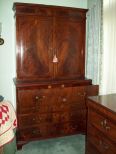Encyclopedia of Antiques
Hepplewhite
Hepplewhite was not a period in itself, but a part of the overall Georgian period. Not too much is know about George Hepplewhite, other than the fact that he was one of the four greatest furniture designers. His shop was located in London, and the Prince of Wales was one of his clients. Some of his time was devoted to work for the Adam brothers, and perhaps that is where the similarity of the two designs lies. His wife took over the business after his death, and books of his designs were then published.
Principal characteristics of his style are shield-like shaped chair seats, well-braced chairs with rectangular stretchers, veneered sideboards, veneered cabinet fronts, slightly curved slender feet on cabinets and chests of drawers, straight legs with spade feet, painted ornamentation (carvings and inlay are secondary), and beautiful moldings.
His chair styles are four: round back, oval back, shield back, and that recognized as the Martha Washington. Carvings include motifs of urns, rosettes, wheat ears, Prince of Wales feathers, and ferns.
Tables are made in three sections held together by brass keepers (like locknuts), and aprons are inlaid and veneered. His card tables are beautifully decorated and are not completely round—either oval or semiround. The top is in two pieces and, when not in use, one half can be raised and placed against the wall (a supporting leg can be swung to the side similar to the gate leg). The Pembroke table has two drop leaves and is small. Chests of drawers have slightly swelled, veneered fronts and slender legs.
Hepplewhite was quite influential in the development of the sideboard. Used for dining purposes it became one of the most important pieces.
Hepplewhite settees are upholstered, with the French influence predominating. Some are like a long chair might be—several oval or shield chair backs are joined together, and many of the arms are of carved wood.
Principal characteristics of his style are shield-like shaped chair seats, well-braced chairs with rectangular stretchers, veneered sideboards, veneered cabinet fronts, slightly curved slender feet on cabinets and chests of drawers, straight legs with spade feet, painted ornamentation (carvings and inlay are secondary), and beautiful moldings.
His chair styles are four: round back, oval back, shield back, and that recognized as the Martha Washington. Carvings include motifs of urns, rosettes, wheat ears, Prince of Wales feathers, and ferns.
Tables are made in three sections held together by brass keepers (like locknuts), and aprons are inlaid and veneered. His card tables are beautifully decorated and are not completely round—either oval or semiround. The top is in two pieces and, when not in use, one half can be raised and placed against the wall (a supporting leg can be swung to the side similar to the gate leg). The Pembroke table has two drop leaves and is small. Chests of drawers have slightly swelled, veneered fronts and slender legs.
Hepplewhite was quite influential in the development of the sideboard. Used for dining purposes it became one of the most important pieces.
Hepplewhite settees are upholstered, with the French influence predominating. Some are like a long chair might be—several oval or shield chair backs are joined together, and many of the arms are of carved wood.


